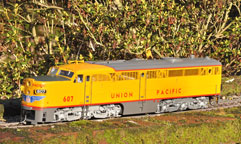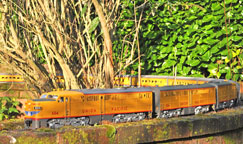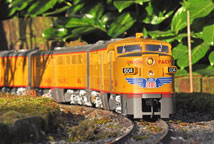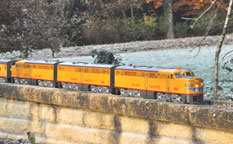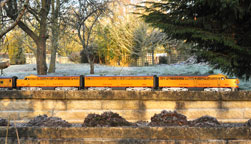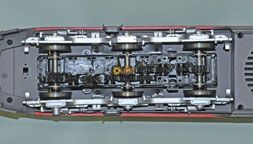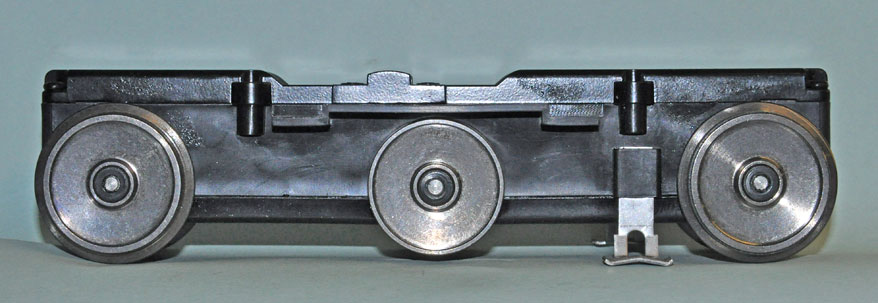The MTH PAs first appeared in late 2010. They are highly detailed models, and quite powerful, the powered A units have a motor in each truck
and weigh just under 5½ pounds. The complete trucks can tilt up and down each end, but not at the sides. The combination of quite long six-axle trucks,
individual axles that are rigid and not sprung or at all loose, combined with scale wheels means that well maintained track is needed for succesful running outdoors.
Modifications:
Electrical: at first, unaltered using the Massoth controller set for 'Analogue'. This gives good control with engine sound, but not horn or bell.
Conversion to DCC followed using Digitrax decoders. The decoders are wired for track AC, the rest of the MTH equipment is fed DC through a rectifier for
lights, smoke and motor sound (in the leading unit). The horn and bell sounds are provided by a Soundtraxx decoder in the rear unit.
Although I have unplugged the lights in the rear unit, I have retained the connectors between the units for the rear smoke unit control.
Couplings: Kadee No 821 couplings were fitted.
Wheels: new wheels with scale flanges were turned from mild steel round bar, bored to 8.2 mm to press onto the existing plastic insulating bushes.
The middle axles wheels on each truck are slightly lower than the outer axles - to get all six wheels to stand level on the track, make the middle wheels 1.4 mm
smaller than the outer. The plastic flanges on the sides of the motor blocks extend over the tops of the middle wheels only. There is enough clearance for
new wheels with scale flanges, but about 0.5 mm will need to be removed to clear the wheels with G1MRA Fine 1.5 mm flanges or larger.
The increased back-to-back wheel spacing (42.4 - 42.5 mm) reduced the pressure of the plunger-type electrical collectors on the backs of the wheels.
This was compensated for by slipping small brass caps over their ends - increasing the reach and at the same time giving a harder wearing surface.
There are 4 plunger-type collectors on each power truck so I removed the skate-type collectors.
1.0 mm wide washers were turned from Delrin to go on the axles inside the wheels to reduce the extra sideplay from my increased b-b.
The locomotive now runs perfectly through my 1.4 mm wide point flangeways.
Final modification, June 2013. Another modeller was having trouble with a converted model with 1.5 mm deep flanges derailing on less than perfect track.
My own units have scale flanges and stay on my rails but are very sensitive to any track imperfections. I had a fresh look at the suspension and have introduced
some vertical movement to the bearings by filing off some of their upper surface, and ensuring free movement in the frame slots. They still felt very solid on
the track so I then added some small coil springs as in the photo above.
